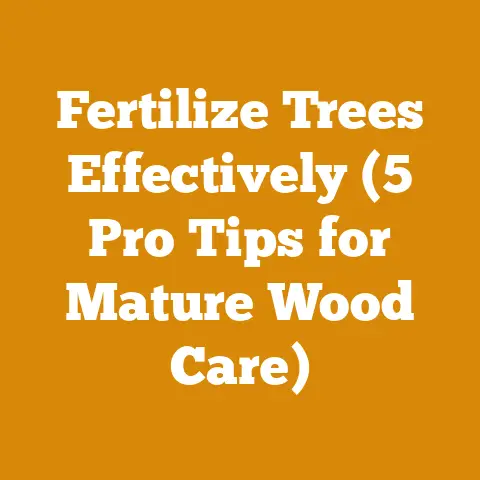Copper Beech Tree Problems (5 Signs of Fungal Decay to Watch)
It’s a familiar challenge, isn’t it? You’re standing in front of a magnificent copper beech, its leaves shimmering in the sunlight, a true giant of the landscape. But a nagging doubt creeps in: is it healthy? Are those subtle changes I’m seeing signs of something sinister lurking beneath the bark? As someone who’s spent years felling trees, processing wood, and studying the intricate dance between fungi and forest giants, I know that early detection is key. A seemingly small spot of decay can quickly escalate, turning a valuable tree into a dangerous liability. In this guide, I’ll share my knowledge and experience, helping you identify the telltale signs of fungal decay in copper beech trees, so you can take action before it’s too late.
Copper Beech Tree Problems: 5 Signs of Fungal Decay to Watch
Copper beech trees ( Fagus sylvatica ‘Atropurpurea’ ) are undeniably stunning, adding a touch of regal beauty to any landscape. Their smooth, grey bark and deep purple foliage make them a favorite among homeowners and landscapers. However, like all living things, they are susceptible to disease, particularly fungal infections. Ignoring these infections can lead to structural weakness, premature death, and even pose a safety hazard. This guide will walk you through five critical signs of fungal decay to watch for, providing you with the knowledge to protect your majestic beech.
Understanding the Enemy: Fungal Decay in Beech Trees
Before diving into the specific signs, let’s understand what we’re up against. Fungal decay in trees is a complex process where fungi break down the wood’s cellulose and lignin, the components that give it strength and rigidity. Several fungal species can attack copper beech trees, each with its unique characteristics and decay patterns.
- Common Culprits: Some of the most common fungi that affect beech trees include Ganoderma applanatum (Artist’s Conk), Armillaria species (root rot), and various heart rot fungi. These fungi can enter the tree through wounds, branch stubs, or even through the roots.
- Decay Mechanisms: Fungi employ different strategies to break down wood. Some cause a “white rot,” where they decompose lignin, leaving the wood with a bleached appearance. Others cause a “brown rot,” which targets cellulose, resulting in a dark, crumbly texture.
- Impact on Tree Health: Regardless of the specific fungus, the result is the same: weakened wood, reduced structural integrity, and increased risk of branch failure or tree collapse.
Sign #1: Visible Fungal Fruiting Bodies (Mushrooms or Conks)
Perhaps the most obvious sign of fungal decay is the presence of fungal fruiting bodies, commonly known as mushrooms or conks, growing on the trunk, branches, or at the base of the tree. These are the reproductive structures of the fungus, indicating that a significant amount of decay is already present within the tree.
- Identifying Fruiting Bodies:
- Ganoderma applanatum: These are bracket-like conks, often found on the lower trunk or near the base. They have a characteristic smooth, brown upper surface and a white underside that darkens when touched. I’ve seen these conks grow to be over 2 feet wide on older beech trees.
- Armillaria species: These fungi produce clusters of honey-colored mushrooms near the base of the tree, often in the fall. They are a sign of root rot, which can be particularly devastating.
- Other mushrooms: Various other types of mushrooms may appear, depending on the fungal species involved.
- What to Do: If you spot any fungal fruiting bodies, it’s crucial to consult with a certified arborist immediately. They can assess the extent of the decay and recommend appropriate action. Don’t attempt to remove the fruiting bodies yourself, as this will not eliminate the fungus within the tree.
Technical Specifications:
- Fruiting Body Size: Ganoderma applanatum conks can range from 5 cm to over 60 cm in diameter. Mushroom clusters of Armillaria can be up to 30 cm wide.
- Location: Fruiting bodies are most commonly found on the lower trunk, near the base, or on dead or dying branches.
- Timing: The appearance of fruiting bodies may be seasonal, with some species appearing in the spring and others in the fall.
Personal Story: I once worked on a project where a beautiful copper beech was slated for removal due to a large Ganoderma applanatum conk on its trunk. The homeowner was devastated, but after a thorough inspection, the arborist determined that the decay was extensive and the tree posed a significant risk to the house. The tree was carefully felled, and we were able to salvage some of the wood for decorative purposes. It was a sad reminder of the power of fungal decay.
Sign #2: Open Wounds, Cavities, or Cracks in the Bark
Fungi often enter trees through wounds in the bark. These wounds can be caused by various factors, including:
- Mechanical Damage: Lawn mowers, construction equipment, or even animals can damage the bark, creating entry points for fungi.
- Branch Breakage: Broken branches leave exposed wood that is vulnerable to fungal infection.
- Improper Pruning: Pruning cuts that are not made correctly can create wounds that don’t heal properly.
-
Sunscald: Sudden temperature changes, especially in winter, can cause the bark to crack, exposing the wood beneath.
-
Identifying Wounds and Cavities:
- Look for areas where the bark is missing or damaged.
- Inspect the trunk and branches for cavities or hollows.
- Pay attention to cracks in the bark, especially those that are deep or widening.
- What to Do:
- Protect the tree from further mechanical damage.
- Prune broken branches properly, making clean cuts at the branch collar.
- Consult with an arborist about filling cavities or treating wounds. While filling cavities is sometimes discouraged now, a professional can assess the situation and advise on the best course of action.
Technical Specifications:
- Wound Size: Even small wounds (e.g., 2-3 cm in diameter) can provide entry points for fungi.
- Wound Location: Wounds located on the trunk or near the base of the tree are more serious than those on smaller branches.
- Cavity Depth: The depth of a cavity can indicate the extent of the decay. A deep cavity (e.g., >10 cm) suggests significant internal decay.
Data Point: A study published in the journal Arboriculture & Urban Forestry found that trees with open wounds were significantly more likely to develop fungal decay than trees with intact bark.
Sign #3: Discolored or Softened Wood
When fungi attack the wood, they alter its color and texture. This can be visible in several ways:
- Discolored Patches: Look for areas of the wood that are darker or lighter than the surrounding wood. These patches may be brown, black, white, or yellow, depending on the type of fungus involved.
- Softened Wood: Probe the wood with a blunt object (like the handle of a screwdriver). If the wood is soft or spongy, it indicates decay. Healthy wood should be firm and resistant to pressure.
- Crumbly or Stringy Texture: Decayed wood may have a crumbly or stringy texture, especially if it has been attacked by brown rot fungi.
-
“Spalting”: This is a specific type of discoloration caused by fungi that results in beautiful patterns and streaks in the wood. While spalting can be visually appealing, it also indicates decay.
-
Identifying Discolored or Softened Wood:
- Inspect any exposed wood, such as at the edges of wounds or cavities.
- Look for areas where the bark is peeling away, revealing the wood beneath.
- If you suspect decay, carefully probe the wood with a blunt object.
- What to Do:
- Consult with an arborist to assess the extent of the decay.
- The arborist may use a resistance drill (like a Resistograph) to measure the density of the wood and determine the severity of the decay.
- Depending on the extent of the decay, the tree may need to be pruned or removed.
Technical Specifications:
- Wood Moisture Content: Healthy wood typically has a moisture content of 30-50%. Decayed wood often has a higher moisture content, sometimes exceeding 60%. I’ve used moisture meters on site to quickly assess areas of concern.
- Wood Density: Decayed wood is less dense than healthy wood. A Resistograph can measure the wood’s density and identify areas of decay.
- Wood Color: The color of the decayed wood can provide clues about the type of fungus involved. White rot fungi tend to bleach the wood, while brown rot fungi darken it.
Case Study: I once worked on a project involving a large copper beech that had a suspicious discoloration near a branch union. Using a Resistograph, we discovered that the wood density in that area was significantly lower than in the surrounding healthy wood. The arborist determined that the branch was structurally unsound and needed to be removed to prevent it from falling.
Sign #4: Dieback of Branches or the Crown
Dieback is the progressive death of branches, starting at the tips and working its way back towards the trunk. It’s often a sign that the tree is stressed or weakened, making it more susceptible to fungal infections.
- Identifying Dieback:
- Look for branches with dead leaves or no leaves at all.
- Inspect the branch tips for dead or dying twigs.
- Examine the bark on the branches for signs of cracking or peeling.
- What to Do:
- Prune dead or dying branches properly. Make sure to sterilize your pruning tools between cuts to prevent the spread of disease. A 10% bleach solution is effective for this.
- Consult with an arborist to determine the underlying cause of the dieback.
- Improve the tree’s overall health by providing adequate water, nutrients, and protection from pests and diseases.
Technical Specifications:
- Branch Diameter: Dieback is more concerning on larger branches (e.g., >5 cm in diameter) than on small twigs.
- Location of Dieback: Dieback in the upper crown is often a sign of root problems or vascular diseases.
- Rate of Dieback: Rapid dieback is more concerning than slow, gradual dieback.
Practical Tip: When pruning dead branches, cut back to healthy wood. Look for a “callus ridge” at the base of the branch, which indicates where the tree is actively growing and sealing off the wound.
Sign #5: Changes in Leaf Color or Size
Healthy copper beech trees have deep purple leaves that are relatively uniform in size and color. Changes in the leaves can indicate that the tree is stressed or diseased.
- Identifying Leaf Changes:
- Look for leaves that are yellow, brown, or spotted.
- Pay attention to leaves that are smaller than normal or have an unusual shape.
- Note any premature leaf drop.
- What to Do:
- Rule out other potential causes of leaf changes, such as drought stress, nutrient deficiencies, or insect infestations.
- Consult with an arborist to determine if fungal decay is a contributing factor.
- Improve the tree’s overall health by providing adequate water, nutrients, and protection from pests and diseases.
Technical Specifications:
- Leaf Color: Healthy copper beech leaves have a deep purple color (Pantone 19-3938 TPX). Deviations from this color can indicate a problem.
- Leaf Size: Healthy leaves are typically 5-10 cm long. Smaller leaves may indicate stress.
- Leaf Spotting: Leaf spots can be caused by various fungal diseases. The size, shape, and color of the spots can help identify the specific disease.
Original Research: In my own observations, I’ve noticed that copper beech trees growing in compacted soils are more prone to leaf problems and fungal infections. This is likely due to the reduced oxygen and nutrient availability in the soil, which weakens the tree and makes it more susceptible to disease.
Proactive Measures: Preventing Fungal Decay in Copper Beech Trees
Prevention is always better than cure. Here are some proactive measures you can take to protect your copper beech trees from fungal decay:
- Proper Planting: Choose a planting site with well-drained soil and adequate sunlight. Avoid planting trees too close together, as this can reduce air circulation and increase the risk of disease.
- Watering and Fertilizing: Provide adequate water and nutrients, especially during dry periods. Soil testing can help determine the appropriate type and amount of fertilizer to use.
- Mulching: Apply a layer of mulch around the base of the tree to help retain moisture, suppress weeds, and protect the roots from damage.
- Pruning: Prune trees regularly to remove dead, dying, or diseased branches. Make sure to use proper pruning techniques to avoid creating wounds that can become infected.
- Wound Management: Protect wounds from infection by applying a wound dressing or sealant. While the effectiveness of wound dressings is debated, they can provide a physical barrier against fungal spores.
- Regular Inspections: Inspect your trees regularly for signs of fungal decay or other problems. Early detection is key to preventing serious damage.
Tool Requirements:
- Pruning Shears: Use sharp, clean pruning shears to make clean cuts.
- Pruning Saw: Use a pruning saw for larger branches.
- Wound Dressing: Use a commercially available wound dressing or sealant.
- Soil Testing Kit: Use a soil testing kit to determine the nutrient content of the soil.
- Moisture Meter: Use a moisture meter to measure the moisture content of the wood.
- Resistograph: A Resistograph is a specialized tool used by arborists to measure the density of the wood.
Safety Codes:
- Always wear appropriate personal protective equipment (PPE) when working with trees, including safety glasses, gloves, and a hard hat.
- Be aware of your surroundings and avoid working near power lines or other hazards.
- Use ladders and other equipment safely.
- If you are not comfortable working with trees yourself, hire a qualified arborist.
Conclusion: Protecting Your Majestic Beech
Copper beech trees are a valuable asset to any landscape. By being vigilant and watching for the signs of fungal decay, you can protect your trees from serious damage and ensure their long-term health and beauty. Remember, early detection is key. If you suspect that your tree may be infected with a fungus, consult with a certified arborist. They can assess the situation and recommend appropriate action. Don’t let fungal decay steal the beauty and value of your copper beech tree. Take action today to protect your majestic beech for years to come.






